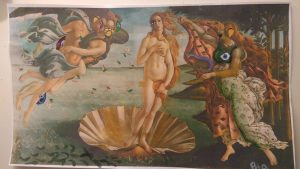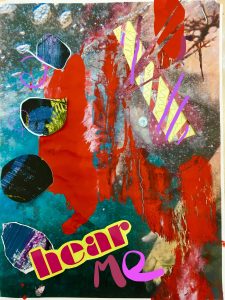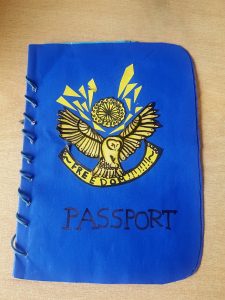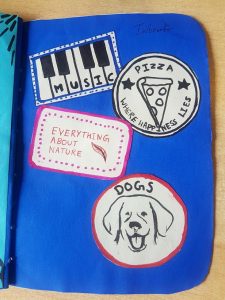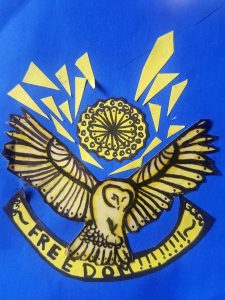The whole process of writing a blog has been a new experience for me – I really struggled at the beginning to find my way around the word press blog system, that was just the technical part. I had to learn the discipline of condensing my thinking into a few words. I did not find that easy. I also struggled with the idea of exhibiting my work online, what would people think of my content? was it good enough? the process has been a steep learning curve. The most difficult task for me was task 7 reading, summarising, and comparing two articles in such a short word count. Unfortunately I went way over the word count on that task. The task I enjoyed most was consuming a book. I read more about the artist Tracey Emin, it really helped me to appreciate her work and discover what motivates her. I have found the whole process illuminating and I am very grateful for the variety of tasks and the opportunity to meet all the tutors through the process
Category Archives: Fine Art
Task 8 by Bianca Schmittmann
I have always liked “The birth of Venus” by Sandro Botticelli. I decided to appropriate this piece of work by painting features of my own style on top of the existing image. Those features that I painted also resemble the work of George Condo as I work with similar techniques therefore appropriating a second artist in this piece.
This process of painting on top of the printed photograph was inspired by the Chapman brothers and their work on Goya’s etchings. I also wanted purposely shock by vandalising this piece, doing that by painting on top of simple A4 paper. using regular paper also takes away the preciousness of the work. I continued to vandalise the piece by tearing a hole in it. If I could change anything, I would love have done this on a bigger scale.
What makes this new work interesting is that it is a combination of old and contemporary art, realism and cubism. The combination of the two different elements that are obvious makes the work relatively attractive to look at. This would also trigger the viewer to want to find all the changes/details and carefully observe the whole piece.
Task 7 by Bianca Schmittmann
In the first text of Art in theory, art critic Leo Steinberg talks about Rauschenberg’s approach to having art presented in a horizontal way, shifting from the old masters way focusing on nature into a more cultural way of presenting work.
in 50’s people were still used to always seeing art in front of us (head to foot) and then Rauschenberg had the idea of a flat surface presentation, to look at art horizontally. Steinberg describes that shift as a “radical shift in the subject matter of art” (Steinberg, p.950) which indicates the importance and intensity, following with “a shift from nature to culture” which highlights the big change in ideals and views.
In the second text, due to Richard Serra’s work Tilted Arc being removed from the specific site and destroyed by the government agency, he reveals his perspective of site specific work in a lecture.
Serra referred to his site specific sculptures to “never decorate, but become part of it and restructure the organisation of the site”. (Serra, p.1125) He is very connected with not only the material but the process of creation. The fact that he the site and the sculpture have to be part of each other changes how some people may have viewed sculptures. This links with Steinberg’s words, linking the two in terms of viewing art: stepping away from tradition and into more modern ideas.
bibliography:
Harrison, C., Wood, P., Steinberg, L. and Serra, R. (2002). Art in theory. 2nd ed. Malden, Massachusetts: Wiley-Blackwell, pp.948- 953, 1124-1127.
Caroline Perkins: Task 9
I chose a picture of an exhibition of Jenny Holzers work, her work sits within the theory of semantics and feminism. I use slogans that represent how I feel about my position as a woman therefore I identify strongly with Holzers work. Jenny Holzer uses language as art. art as language has been debated over time looking at the theory of semiotics and the visual as language. Holzer uses the semantics, the meaning of the words in the context of a random sign in a poster on a subway wall or using an anonymous information system of LED lights takes the lexicon of the words and asks the audience to engage with the phrase. The meaning of the phrase is brought to the work by the viewer and their own position in the culture. Also, her work can be viewed from a position of Feminist theory. Jenny is speaking in a language made and developed by the patriarchal society and meaning can be interpreted by men and women in completely different ways. Jenny would listen to the debate of the general public as they discuss the work found pasted on walls in public places.
Task 12- Victoria- Tomi Olumide
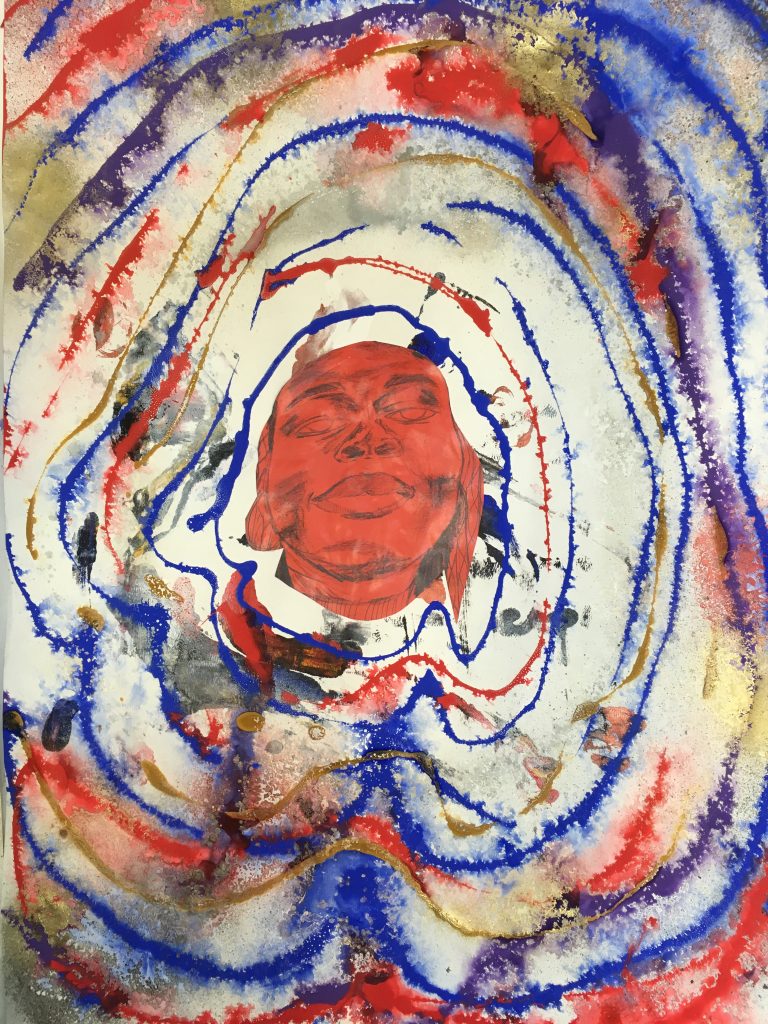
Submerge in Utopia
Tomi Olumide
2017
Mixed Media
446 x 635mm
A mixed media self-portrait created with the aid of Acrylic paint, photocopied paper, spray paint and spray bottle. Creating a piece towards my contemporary project and dabbling in a pool of uncertainty towards the final outcome, however baring the reflection of my identity, by using a photocopied scaled down print of a lead drawing on red paper (most beloved colour).
The size is about 420 x 594mm in a portrait orientation. I would like to enlarge the scale of the work by making the entire piece a wall mural (about 5 ft on both sides), surface made of primed MDF board, Stretched canvas or panel primed board of the same scale, hung to or nailed to the supporting wall it’s anchored by.
I cannot imagine the presentation of the work being in any form other-than rectangle, however it might be interesting to see it in an irregular shape too. I would however like the subject to be different, as it seems very narcissistic to have a blown image of my face. Having subjects or characters that are of a worthy cause or community project would be the subject matter. Where I could make a repeat pattern of the (image above with different subject matter) positioned in various angles, incorporating text, motifs, and collaged elements of sculptural objects relating to the theme of the work or fragments of my imagination which are aesthetically pleasing in paring the work.
I think having a play with non 2 dimensional objects with the wall mural would be interesting to show a distinction of the form and also illusion of relevant elements to the subject matter, which could either capture the audiences interest or bore them, for the most part I hope for the first.
Another way to illustrate this could be to make a short animation which would be in illuminated effect show the motion of the hovering rings of colour around the centralised object or character. In my head It appears like the ‘moving- atom’ from the popular animation ‘Jimmy Neutron’.
Task 11- Victoria- Tomi Olumide
My blog has been a portal for displaying my written assignments. Honestly I did not enjoy the method of displaying my work to the public, as I was under the notion that it would be in confidence between tutors and students, nevertheless I do understand the objective of it preparing one for the mind-set of being confident with displaying their written work, more so sharing their opinions with others in a public space, and not being too precious and sentimental with opinions. Guarded I mean.
I’ve used evaluation templates from college and also articles on sites like artnet.com and a few others which I randomly looked through as a source of inspiration. So my words wouldn’t seem so muddled when portraying my thoughts. The worst thing is having your words not being seen in the best light and with the intentions you had whilst making them up.
I think the most important lesson I’ve learnt is not to procrastinate, it’s a bitch in every sense of the word. Feeling like you would get to it, and find yourself rushing to meet deadlines, it’s the most pathetic, depressing, embarrassing and dreadful thing that could demoralise an individual. And my words of comfort to myself after self-reflection on my performance through this semester is. Get a grip and lastly motivation is a lie so get your shit together
In past times before now, I had like I’m sure others did purposely ignored the entries of their contemporaries who had given early submissions, because of the shame or the reminder of responsibility. I’ve learnt that sometimes we need that pressure, we need that feeling of guilt, to remind us to just get on with it. So many reasons to babble on however I have more work to do.
Task 8- Victoria- Tomi Olumide
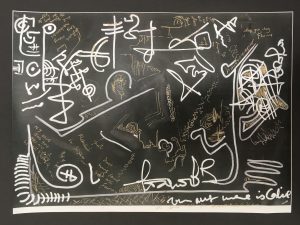
Original Untitled
Tomi Olumide
2017
Ink on photocopy
21 x 29.7cm
The work above is a darkened grey scanned photocopy holding markers (drawing tools). Initially made for a studio drawing workshop which I changed my mind towards using. It however worked very well in these adaptations, as I have appropriated elements of this piece into the following works.
I was inspired to create this style of work from the influence from a past drawing workshop which had involved photocopying art works we were interested in for our Contemporary Art project. I’m also very interested in incorporating text and motifs into my drawings and paintings, as it’s a very animated habit which mediates between childishness and passion of defining my points through verbal representation. I have found using motifs and figurative drawings or lines are a way to obscure my messages, be playful as well as distract my audience from the entire context of the work, while at times they could be guidelines to the context of the work.
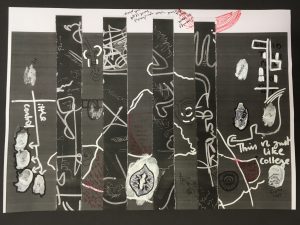
Blank Untitled
Tomi Olumide
2017
Ink on Collage
21 x 29.7cm

Red Untitled
Tomi Olumide
2017
Ink on Collage
21 x 29.7cm
On the surface of the work are irrelevant lines and also text which do depict my personal frustration with my relationship at the time. Drawing on the scanned piece, was in fact a way to relieve myself of the tensions which resided within my mind at the time. Then unaware of the possibilities of carrying on the sequence of reproducing it into other forms, that still communicate emotional frustration, joy of transitioning into something more.
I used a photocopy of the work above and cut it in in a horizontal position, where a curtain looking omitted gap like bar graph was formed. This template became a flexible means to reproduce my ideas in various juxtapositions. The individual backgrounds becoming the supporting image laying against the back of the curtain strip, would in fusion with the strips form a collage of the two independent pieces merging them into one body, where the printed resulted would be further worked on with white and metallic ink drawings on its body. There forming the works ‘Red Untiled’ and ‘Black untiled,’ which illustrate the themes described in the ‘Original untiled’.
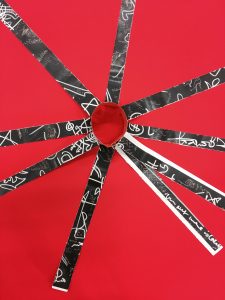
Chocker tentacles
Tomi Olumide
2017
Paper Sculpture
The curtain stripped piece was played with further by arranging it in positions of jewellery, like a choker necklace but with 9 black tentacles camouflaged in white and gold inscriptions.
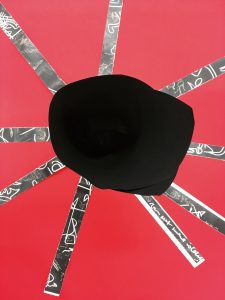
Blood rose
Tomi Olumide
2017
Paper sculpture
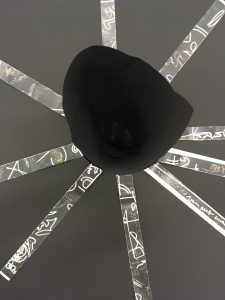
Silent rose
Tomi Olumide
2017
Paper sculpture
Whilst still in this position, I would take the choker necklace to be the anchor for a black paper rose, on the background of either Red or Black A3 paper, to engulf the full length of the tentacle strips. The miniature sculptures titled ‘Blood rose and Silent rose.’
After this the combination of the 4 works would then make my sarcastically titled end piece to conceal or Nah?. A collage of these pieces ‘Original untitled+ Chocker tentacles + Red Untitled + Black Untitled+ Red figurative drawing of male genitalia, then resulted in To Conceal or Nah?
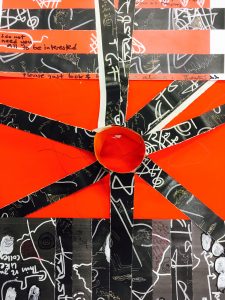
To Conceal or Nah? Tomi Olumide 2017 Mixed media
21 x 29.7cm
Caroline Perkins: Task 10, Hear Me!
Dawning Day,
Sharp Knives Marching
Cold
Swimmers Shouting
Rain Sky
Hear Me, Caroline Perkins
This work represents my practice in so much as there are many techniques I have started to develop and use in the making of my work. I have started to insert popular slogans and slogans that I resonate with from my feminist position. I am also experimenting with printing using the technique to deliver a more randomizing effect which places me at a distance from the piece. During the workshops I was introduced to the process of intercutting, which I feel helps me to move into and through my work to access and discover further ideas, working from the negative and positive spaces in the work using edges to define past and future. I have found looking into the work of Jenny Holzer Caes Oldenburg, Ilya and Emilia Kabakov. these artists have expanded my views of the authenticity of adding words and other artefacts to my work. I have chosen the 10 words for their visual imagery it is a verse from a poem I have written to describe the context of the original photo.
Task 1
Upon receiving the passport brief, I realised how strangely significant these legal documents are; they prove our identity and existence. One aspect of the passport that I was particularly interested in was its ability to let us travel. My jejune version of the passport lets me travel back to my childhood when I desired the simplest things. To create this childish mien, I used primary block colours for the cover which is coiled by a baby blue rubber band. The image that represents my fictional country depicts a golden owl which is inspired by my childhood obsession with birds. The concept of travel is reinforced by the banner below the bird which reads “Freedom”. The stamps inside the passport contain poorly drawn symbols of my interests which, despite growing older, hasn’t changed. Ideally, I would’ve liked to include more personal information about myself but couldn’t muster enough confidence.
Task 7
Leo Steinberg’s classic Other Criteria: Confrontations with Twentieth-Century Art (1972), discusses the sudden and unexpected shift in the way art was perceived and created during the 1950s. Influenced by the flatbed printing press, Steinberg correlates the pictorial surface of art with the “human posture”; he comments on the way cultural, social and political situations mould art. The changing mentalities forced a change in the way art is conceived; Steinberg explores the conception of the “picture as representing a world, some sort of worldspace”. Steinberg focuses on the works of Robert Rauschenberg and Dubuffet who have distanced from the previous “vertical fields” and transitioned into “opaque flatbed horizontals” thus altering the subject matter of art to emphasize culture over nature. This new orientation resulted in the modification of both the physicality and definition of art. Like Steinberg, Richard Serra (from the Yale lecture 1939) also comments on the changing orientation by referring to the way traditional means of creating sculptures have been replaced by new technology and industry. As a result, the concept of site-specificity has altered; “a new behavioural and perceptual orientation to a site demands a new critical adjustment to one’s experience of the place. Site-specific works primarily engender dialogue with the surroundings.” (pg. 23-33)
Charles Harrison, C, and Wood, P. (1999) Art in Theory, 1900-1990. An Anthology of Changing Ideas. Oxford: Blackwell

